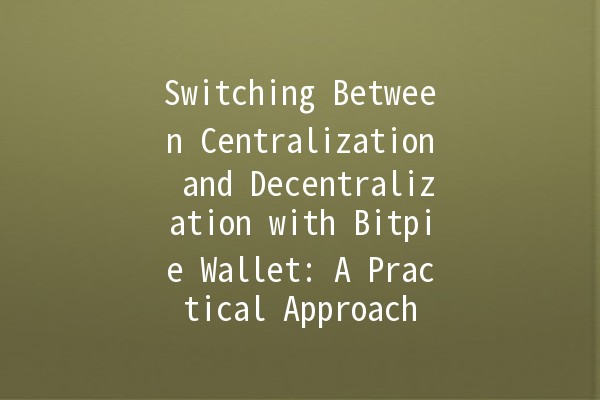
In contemporary discussions surrounding digital wallets, the concept of centralization versus decentralization plays a pivotal role. Bitpie Wallet, a renowned cryptocurrency wallet, epitomizes this duality by offering its users the flexibility to transition between centralized and decentralized management of their assets. This article dives into the intricate aspects of this feature, providing actionable tips and strategies for users navigating this complex terrain.
Understanding Centralization vs. Decentralization in Wallets
What is Centralization?
Centralization refers to a system where a single entity has control over the data and transactions. In the context of wallets, centralized methods often involve thirdparty services that facilitate transactions and asset management. Users typically benefit from convenience, streamlined processes, and enhanced security measures; however, they must also place trust in these thirdparty entities.

What is Decentralization?
Conversely, decentralization allows users to maintain complete control over their assets without relying on intermediaries. Users generate and manage their wallets independently, enhancing privacy and autonomy. Nevertheless, this independence could lead to challenges like user error, loss of access to assets, and heightened security risks from mismanagement.
Bitpie Wallet's Unique Position
Bitpie Wallet seamlessly integrates both centralization and decentralization, providing users with the option to choose the most suitable method for their situation. This adaptability allows for a tailored approach to managing digital assets according to user preferences and expertise.
Five Productivity Tips for Switching Between Centralization and Decentralization
Before making any transitions, users should assess their specific needs. Are you prioritizing security, ease of use, or control over your assets? Understanding these factors can significantly influence your choice between centralized and decentralized management.
Example: A casual user who frequently transacts may prefer centralized services for convenience, while more experienced users who prioritize security might lean towards decentralization.
Bitpie Wallet offers various features that cater to both models of asset management. Users should take the time to explore these features and understand how to leverage them effectively.
Example: Utilize Bitpie's builtin tutorials or community forums to better grasp how to switch modes, ensuring that you are prepared to manage your assets effectively no matter your choice.
Security should remain a top priority, especially when managing assets across different platforms. Regular audits of your wallet settings, security features, and recovery options can prevent potential disasters.
Example: Set reminders every three months to review your wallet's security settings, ensuring that authentication measures such as multifactor authentication (MFA) remain robust.
Whether you choose a centralized or decentralized method, establishing a comprehensive backup strategy is crucial. This may include backing up your private keys or accessing recovery phrases.
Example: Utilize cloud services to store backups securely, or keep physical copies in a safe place—both methods can protect you from unintended access loss.
The cryptocurrency landscape evolves rapidly; therefore, users should remain proactive in learning about new technologies, trends, and threats related to wallet management.
Example: Follow reputable cryptocurrency blogs, subscribe to podcasts, and participate in community discussions to stay updated on best practices and innovations.
Choosing the Right Mode for Your Transactions
When to Use Centralized Methods
Centralized methods can be beneficial for daily transactions, as they often provide a more userfriendly interface and quicker transaction processing times. Investors who are new to cryptocurrency may find centralized wallets to be a suitable starting point.
When to Use Decentralized Methods
Users who prioritize security and privacy should consider decentralized methods. These allow for greater personal control without relying on a third party's security measures. If you plan to hold assets for the long term or participate in decentralized finance (DeFi) applications, a decentralized approach is more appropriate.
Transitioning Seamlessly
Bitpie Wallet allows users to transition seamlessly between centralized and decentralized modes. This flexibility is crucial during market volatility, enabling users to adjust their strategies quickly.
Frequently Asked Questions (FAQs)
Centralized wallets can be vulnerable to hacking attempts, making them targets for cybercriminals. Users must trust the wallet's provider to secure their information and assets. It is advisable to use reputable wallet providers and employ additional security measures.
Yes, you can recover your assets if you have saved your private keys or recovery seed phrase securely. It is essential to keep this information private and safe, as unauthorized access can lead to irreversible loss of funds.
For beginners, a centralized wallet typically offers the easiest onboarding experience, with simpler interfaces and customer support. However, as users gain confidence and knowledge, transitioning to decentralized methods is encouraged for improved security.
Bitpie Wallet prioritizes user privacy by allowing users to manage their private keys and offering anonymity features. Centralized aspects do not compromise privacy, fostering a secure environment for transactions.
To maximize the security of your decentralized wallet, consider using hardware wallets for storage, enable twofactor authentication, and ensure your backup strategy is wellplanned to protect against data loss.
The frequency of switching depends on market conditions and personal asset management strategies. Monitor trends and assess your needs to determine when it’s best to switch modes.
Staying Informed and Ready to Act
Navigating the balance between centralization and decentralization in managing cryptocurrency assets, particularly with Bitpie Wallet, requires a proactive approach to learning, security, and decisionmaking. By weighing personal needs, understanding available features, and staying informed about industry trends, users can make informed choices that enhance their overall digital asset experience.
In summary, the ability to switch between centralized and decentralized wallets provides a unique opportunity for users to optimize their asset management strategies. Through education, security measures, and continuous improvement, users can take full advantage of Bitpie Wallet's flexibility, ensuring they are wellequipped to tackle the challenges of the changing digital landscape.

